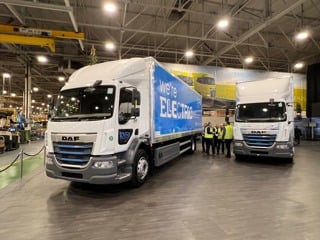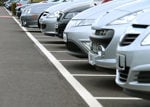Fleet News Awards: Best upper medium car - Mazda6
It’s 11 years since the original Mazda6 helped transform perceptions of the Mazda brand in the UK.
The range had become, with one exception (the MX-5), a collection of worthy-but-mostly-dull traditional sector cars that were never anywhere near as good as the best in class and certainly weren’t desirable.
The Mazda6 of 2002 set the tone for an entire range refresh that would revitalise the appeal of the brand; it majored on driver appeal, value and styling in that order.
At the time, Mazda was tethered to Ford (which was a major shareholder in the company), and although the Mazda6 had little in common with European Ford products, the Mazda2 and Mazda3 that followed were heavily reliant on shared technology.
But as challenging economic times saw Ford divest itself of some of its interests in other brands, Mazda would soon be left to go it alone while rivals were increasing investment in hybrid technology as well as cleaner petrol and diesel engines.
Although Mazda revised the Mazda6 in 2007 (as well as the Mazda3 a couple of years later), these were not all-new models and were merely eking extra life from these still-competent cars as the company focused investment on its new big project: Skyactiv.
The name is given to the all-encompassing fuel-saving technology behind Mazda’s sixth-generation products, which started with the CX-5 in 2012 (which was highly commended for Best Crossover in the 2013 Fleet News Awards) and continued with the 2013 Mazda6, launched in the UK in January.
It includes a focus on reducing weight in the structure and powertrain, as well an starting with a clean sheet of paper for both petrol and diesel engines to ensure conventional technology is as efficient as possible before exploring hybrid and other technology.
Mazda’s head of fleet, Steve Tomlinson, has been in the job for around a year, and says effective communication is key to ensuring customers understand the benefits of the technology involved in Skyactiv.
Fleet News: Fleet customers have probably heard of EfficientDynamics, Bluemotion and Econetic, among others. How difficult is it to get them to understand Skyactiv and what it involves?
Steve Tomlinson: We just need to demonstrate to customers the benefits of the technology.
When company car drivers are considering their options we have low CO2 and competitive pricing on our side, but the performance of the car isn’t compromised.
You don’t have to choose a low power variant.
We can talk in terms of how the technology has a direct benefit to customers and drivers .
FN: Mazda hasn’t undergone consistent growth in fleet over the past few years. How much of a challenge will it be to win back customers?
ST: Last year Mazda6 had a very successful run-out strategy and we were sold out by September, which left the way clear for the new model.
We were able to give a lot of information to leasing companies so they were able to quote rates as early as possible on the new Mazda6.
Although our fleet sales declined in 2012, it was a planned reduction based on refreshing the range.
We haven’t always had the right product in recent years for customers who have chosen Mazda before, but we have kept in touch with them and now that we have some new products to talk about they seem to be keen to listen to what we have to say.
FN: What impact has this decline had on the team?
ST: When you’re selling fewer cars, you don’t need to have such a large team.
But now we have realigned the structure, we have nationwide coverage and should volume pick up at a greater rate than we expect, it’s easy to add additional regional corporate sales managers. The structure is now future-proof.
FN: Is there any scope for the dealer network to win new business?
ST: Our fleet specialist dealers are expected to grow. Traditionally they have been larger dealer groups that handle fleet business with other brands as well as Mazda.
We plan to increase these by 25% to engage local businesses. Coverage is becoming more important to people we work with.
FN: In the past Mazda has benefited from economies of scale through working with Ford and other partners to develop products. Now Mazda is on its own, will it be more of a challenge to be profitable?
ST: All our Skyactiv cars are developed from a modular platform, so we effectively have one platform for our whole range. We will derive economies of scale in this way rather than sharing development with other manufacturers.
FN: What are your expectations for the car industry in the UK over the next few years?
ST: Car sales are expected to be fairly flat for the next four to five years, although it is difficult to predict whether recovery will begin sooner. However, we expect to grow significantly in 2013 and beyond, and fleet will be a key driver behind this growth.
The next big fleet product for Mazda will be the Skyactiv Mazda3, which will be revealed late in June and is expected to make its public debut at September’s Frankfurt Motor Show before going on sale in the UK by the end of the year.
However, Mazda’s UK sales in 2013 are expected to reach 32,000 units – significantly ahead of the 2012 total of around 25,500. In 2012, Mazda registered about 4,000 units to fleets, while in 2013 it expects this to grow to about 8,500.
Tomlinson said he expected Mazda to register about 1,000 cars into Motability in 2013, but would be targeting end-user fleets for the rest of the company’s growth.
“We might have started from a relatively low base,” said Tomlinson, “But we’re expecting to grow in fleet by more than 100% in 2013 and this is largely on the back of Skyactiv technology.”
Fleet manager and company car driver interest in the Mazda6 has led to a tripling of the manufacturer’s corporate demonstrator fleet.
There are now a total of 225 Mazda6 vehicles on the manufacturer’s corporate demonstrator fleet with the marque having originally planned to have 75 vehicles.
Where the original Mazda6 sold on its driver appeal, value and style, these factors are still to the fore in the latest model, but it now also offers class-leading fuel efficiency and low CO2 emissions.
These were absent 11 years ago as the CO2-based company car tax regime was still new and far less punitive to high-
emission cars than it is now.
But Skyactiv seems to have reached the market at a critical time, and Mazda seems poised to take full advantage.
Judges’ comments
The Mazda6 offers power with efficiency. Its ground-breaking technology using lightweight
materials and re-engineering of the drivetrain has resulted in excellent, highly efficient petrol and diesel engines. The car is also well equipped and exceptional to drive, while the judges noted the fleet friendly badging for a simplistic line up.






















Login to comment
Comments
No comments have been made yet.